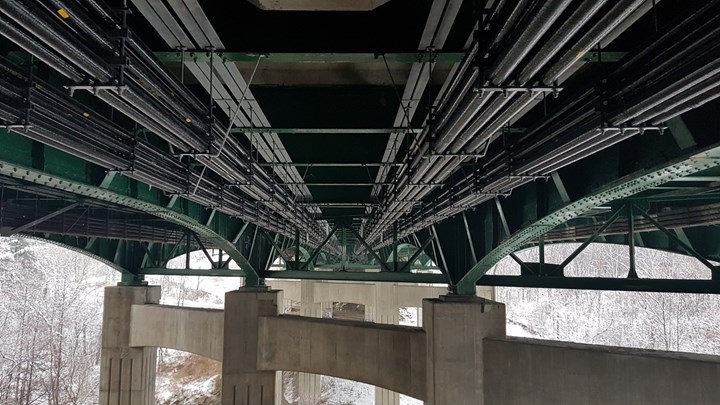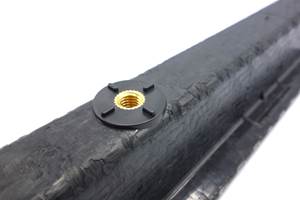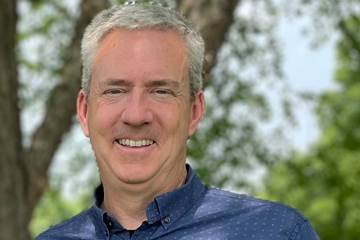Fiberglass conduit manufacturer grows into new products, infrastructure applications
Texas-based Champion Fiberglass, a five-time CW Top Shops honoree, expands its success in the fiberglass composite conduit market into new applications and products, looking toward future automation and sustainability initiatives.
Since the beginning, fiberglass composite conduit remains a key business for Champion Fiberglass. Source, all images: Champion Fiberglass
Champion Fiberglass Inc. (Spring, Texas, U.S.) was founded in 1988 with a focus on manufacturing fiberglass conduit for protecting electrical and other utility wires and cables — “and this is still our main business today,” explains Goran Haag, founder and executive chairman.
Over the years, the company, which now operates a 120,000-square-foot facility with 165 employees, has branched out into related fiberglass composite industrial and utility infrastructure applications. These include ducts, struts and bridge drains that can be used in applications ranging from chemical plants to mines to wastewater treatment facilities to above and underground utilities.
Champion Fiberglass is one of the honorees for CW Top Shops 2023 — in fact, the company has achieved this distinction every year since the program began, in 2019, 2020, 2021, 2022 and now most recently in 2023.
The growing need for durability of utility and civil infrastructure (such as the pictured bridge application) against extreme weather conditions provides opportunities for growth for Champion Fiberglass’s corrosion-resistant, durable composite ducts, conduits and struts.
Beyond the data, what makes these facilities stand out? The CW team asked each of the latest honorees to share more about their companies’ histories, goals and trends in the composites industry.
The following Q&A features responses from Goran Haag:
CW: What composite materials and processes do you work with?
Haag: Materials include fiberglass with a range of resins such as epoxy, phenolic and vinyl ester, as well as sheet molding compound (SMC).
Processes include filament winding, compression molding and vacuum infusion.
We started with filament winding and compression molding for our electrical conduit, but as we started moving into bridge drains and other types of applications that are used for plumbing or that require different fittings, over the past few years we have started to work more with vacuum infusion as well. We also make all of our own molds in-house.
CW: What end markets do you serve?
Haag: The infrastructure, industrial and marine markets.
CW: Reflecting back on 2023, what was your company’s top achievement or strength?
Haag: As a company, we just keep growing, and we have had some big orders in the last year. We also have a really great staff of really good people, and I can’t say enough about them.
Champion Fiberglass currently operates three filament winding machines (like the one pictured), with plans to fully automate the process and expand to add a fourth system.
CW: What goals does Champion Fiberglass have going into 2024, or what opportunities do you see ahead?
Haag: We are getting very close to launching a new product, a fiberglass cable tray. In industrial buildings or convention centers or other large buildings, these are essentially ladder structures that are hung across the ceiling and you drop electrical cables from them. Typically these are made from aluminum or steel but we are making a fiberglass composite version that eliminates issues with corrosion.
On the conduit side of the business, we are also expecting to grow very aggressively there. There is a large effort right now to protect utilities against extreme weather, especially in certain areas prone to wildfires like in California, or in areas like Florida prone to hurricanes, so a lot more utilities are now going to go underground. And I think fiberglass conduit is the obvious choice there because of the corrosion issues you’d have with metals. So we’re anticipating a lot of growth in that market.
CW: How does sustainability factor into your operations?
Haag: We have made major investments in this area. We decided we wanted to find a use for our manufacturing waste, so we invested in a big crusher and grinding machine. Now, we take all scrap and crush and grind it into basically a sand that can be used as a filler in cement or some other type of application. Using this equipment has cut down our waste to landfill by about 85-90% in the last year, and I’m very proud of that.
In addition, we are working with our fiberglass supplier Owens Corning to see how we can be more environmentally friendly there. They’re looking at whether they can take fiberglass wind blades or other products, melt them down at their end of life (EOL) and then remake the parts back into glass again.
CW: Does your facility employ automation, or plan to do so? If so, what processes are or will be automated, or what opportunities do you see in this area?
Haag: We are currently working on automating all of our filament winding equipment. We have three winding machines right now, likely a fourth in future, and the goal is for them all to be completely automated. We’re also looking into some robotics for some of our processes.
Related Content
Robotized system makes overmolding mobile, flexible
Anybrid’s ROBIN demonstrates inline/offline functionalization of profiles, 3D-printed panels and bio-based materials for more efficient, sustainable composite parts.
Read MoreBioabsorbable and degradable glass fibers, compostable composite parts
ABM Composite offers sustainable options and up to a 60% reduction in carbon footprint for glass fiber-reinforced composites.
Read MoreUnderstanding vacuum bagging layers in production, repair
Recognizing the functions of each layer in a vacuum bag schedule can help users discover what vacuum bag schedules work best for their application.
Read MoreAl Seer Marine, Abu Dhabi Maritime unveil world’s largest 3D-printed boat
Holding the new Guinness World Record at 11.98 meters, the 3D-printed composite water taxi used a CEAD Flexbot to print two hulls in less than 12 days.
Read MoreRead Next
Finnish boatbuilder balances history, innovation in fiberglass composites design
CW Top Shops honoree Sargo Oy shares its successes in upgrading operations from hand layup to infusion, employing low-waste manufacturing practices, research in large-format 3D printing for mold production and more.
Read MoreBallistic protection panels manufacturer relies on automation for high throughput, efficiency
Maine-based CW Top Shops honoree Compotech Inc. recently doubled its manufacturing space and team to produce modular composite panels for defense applications via light resin transfer molding (LRTM).
Read MoreEpisode 42: Jeff Sloan, CompositesWorld
CW publisher and brand V.P. Jeff Sloan discusses the history of CW and the evolution of the composites industry during his time as editor.
Read More
.jpg;width=70;height=70;mode=crop)
















.jpg;maxWidth=300;quality=90)







